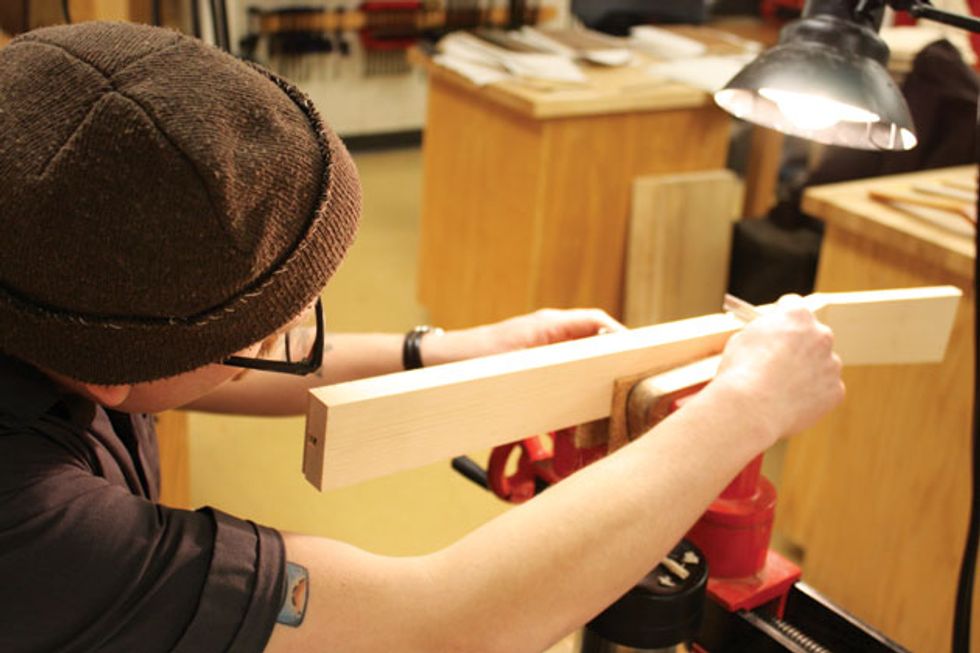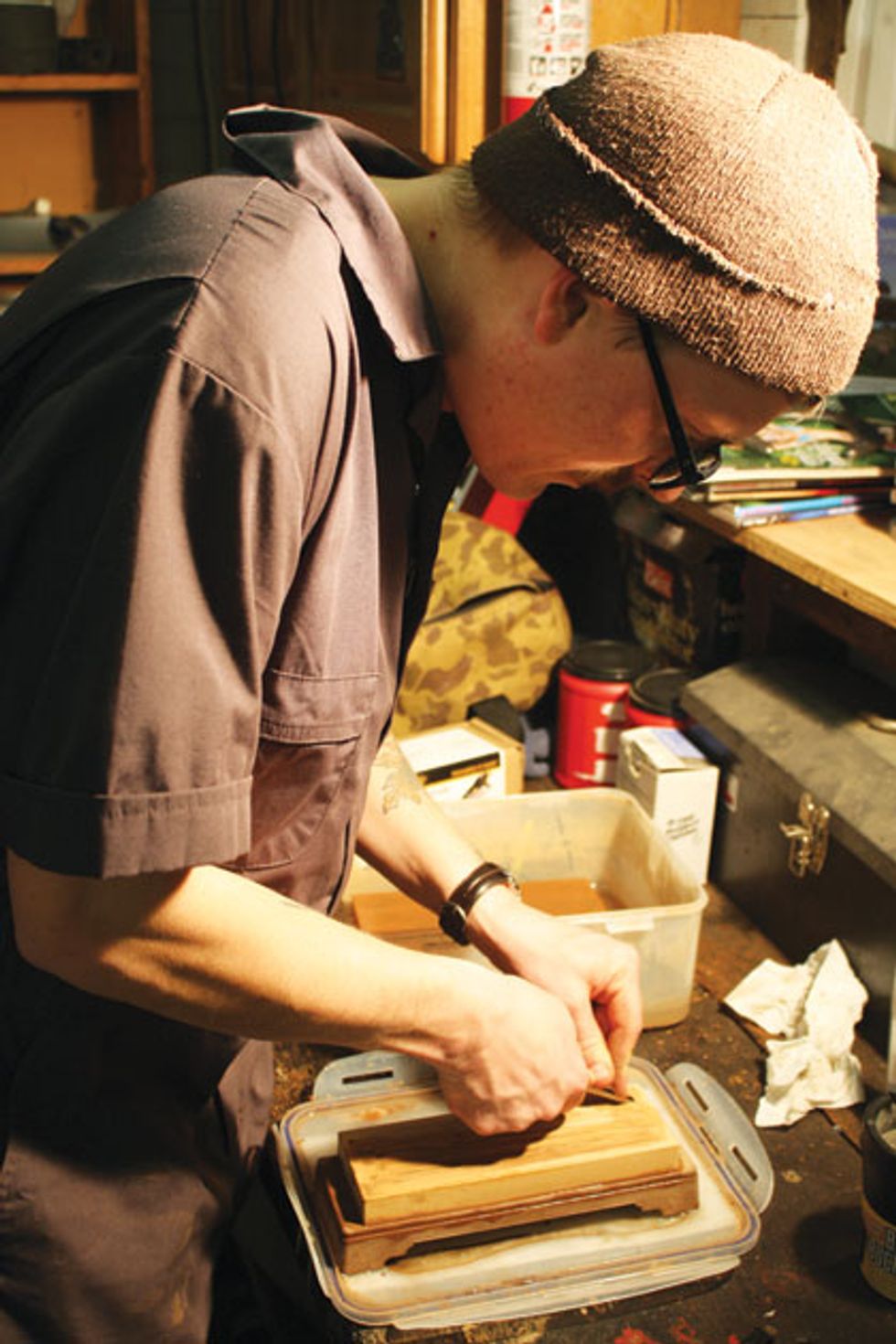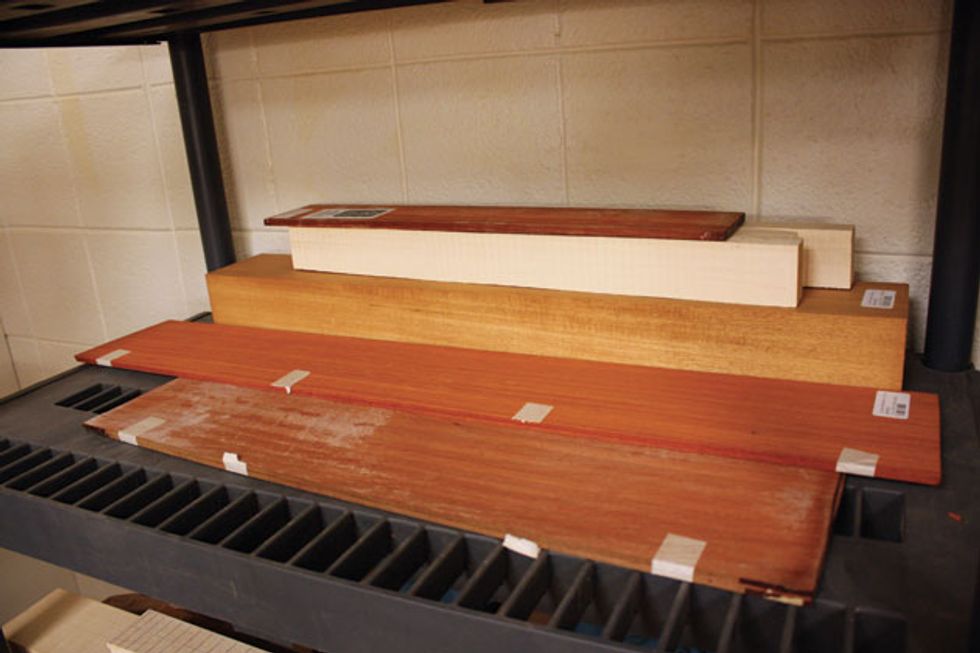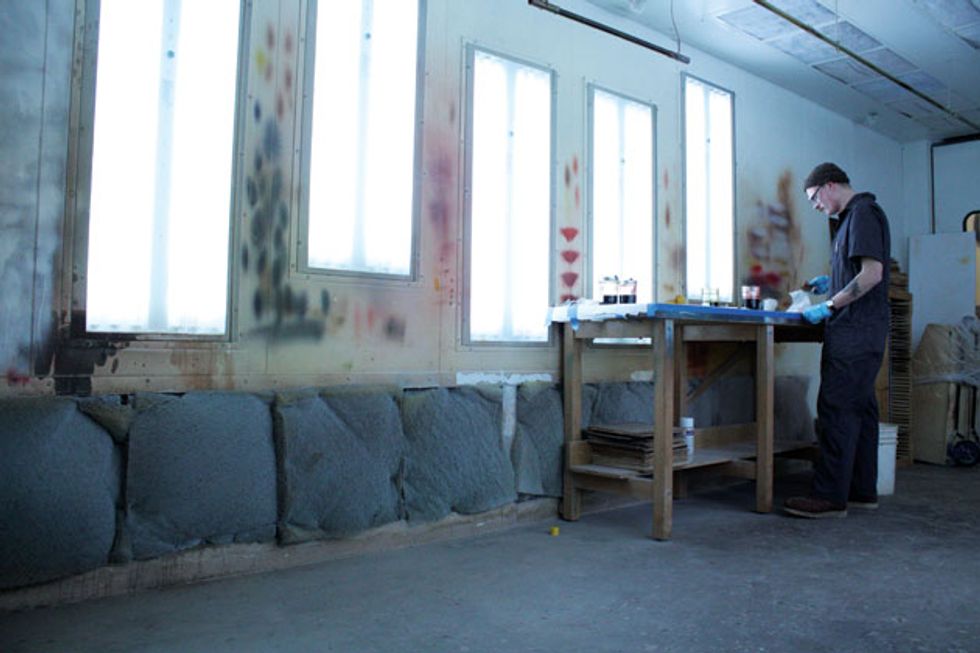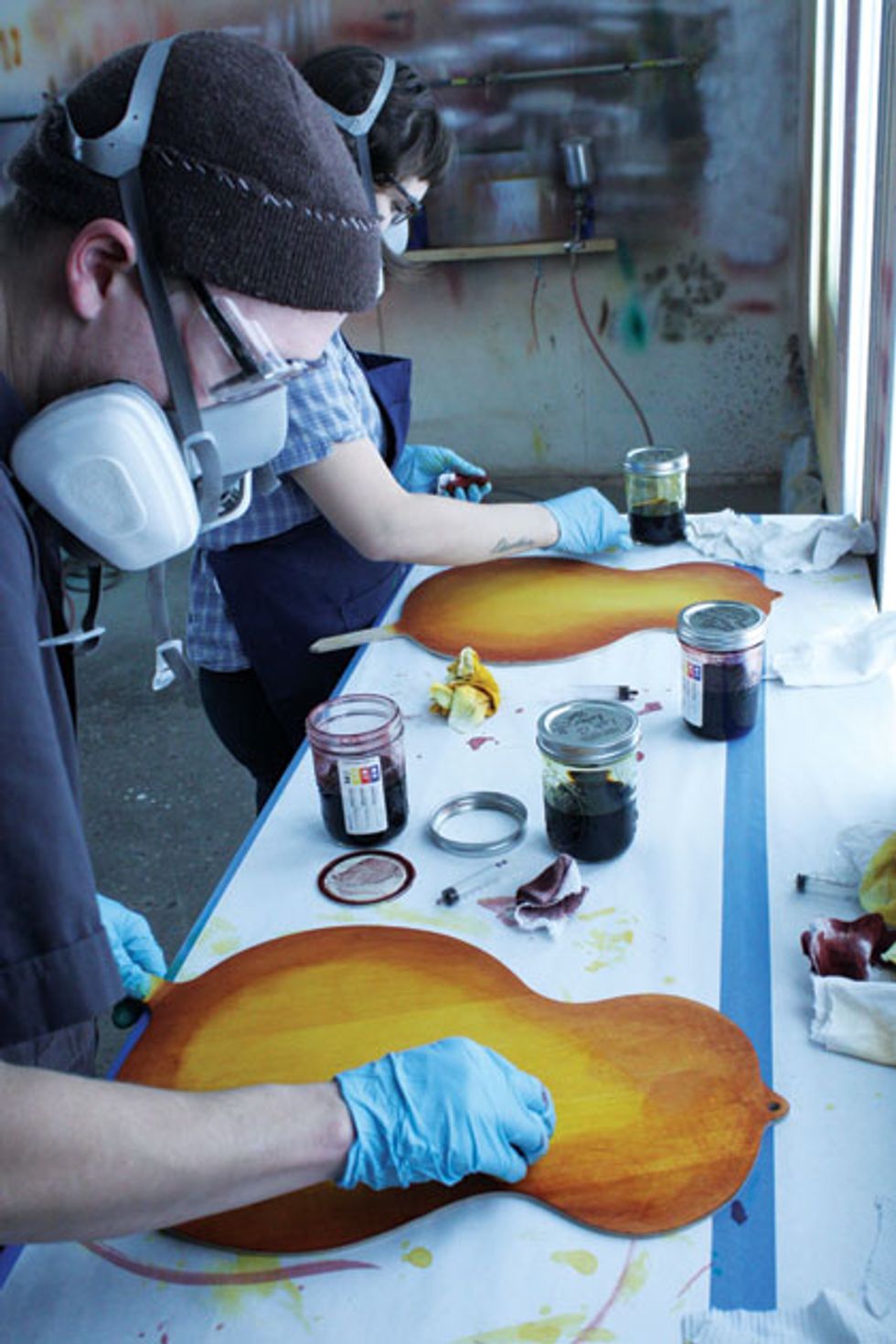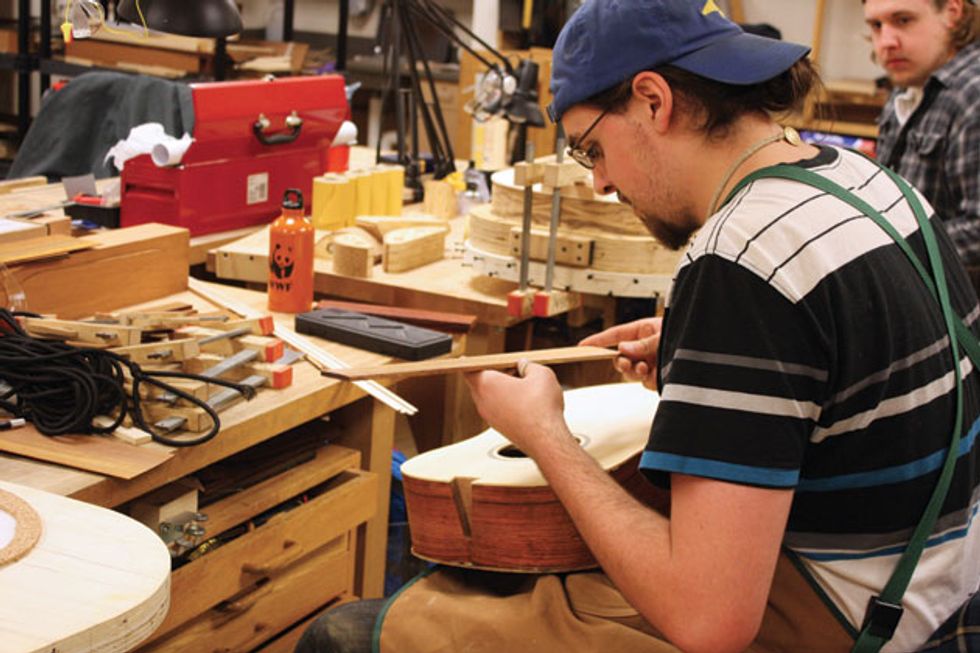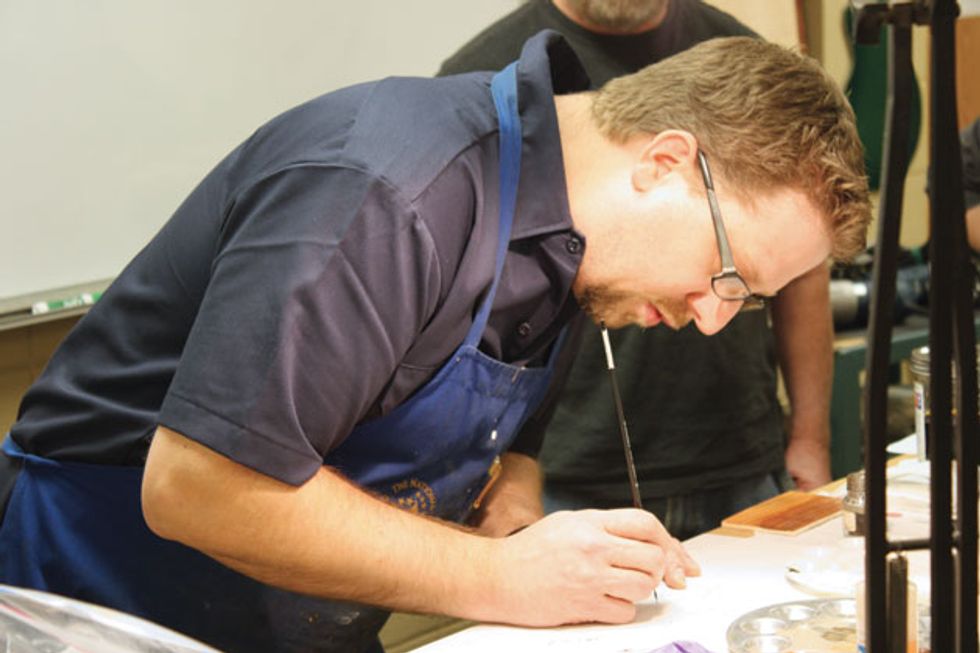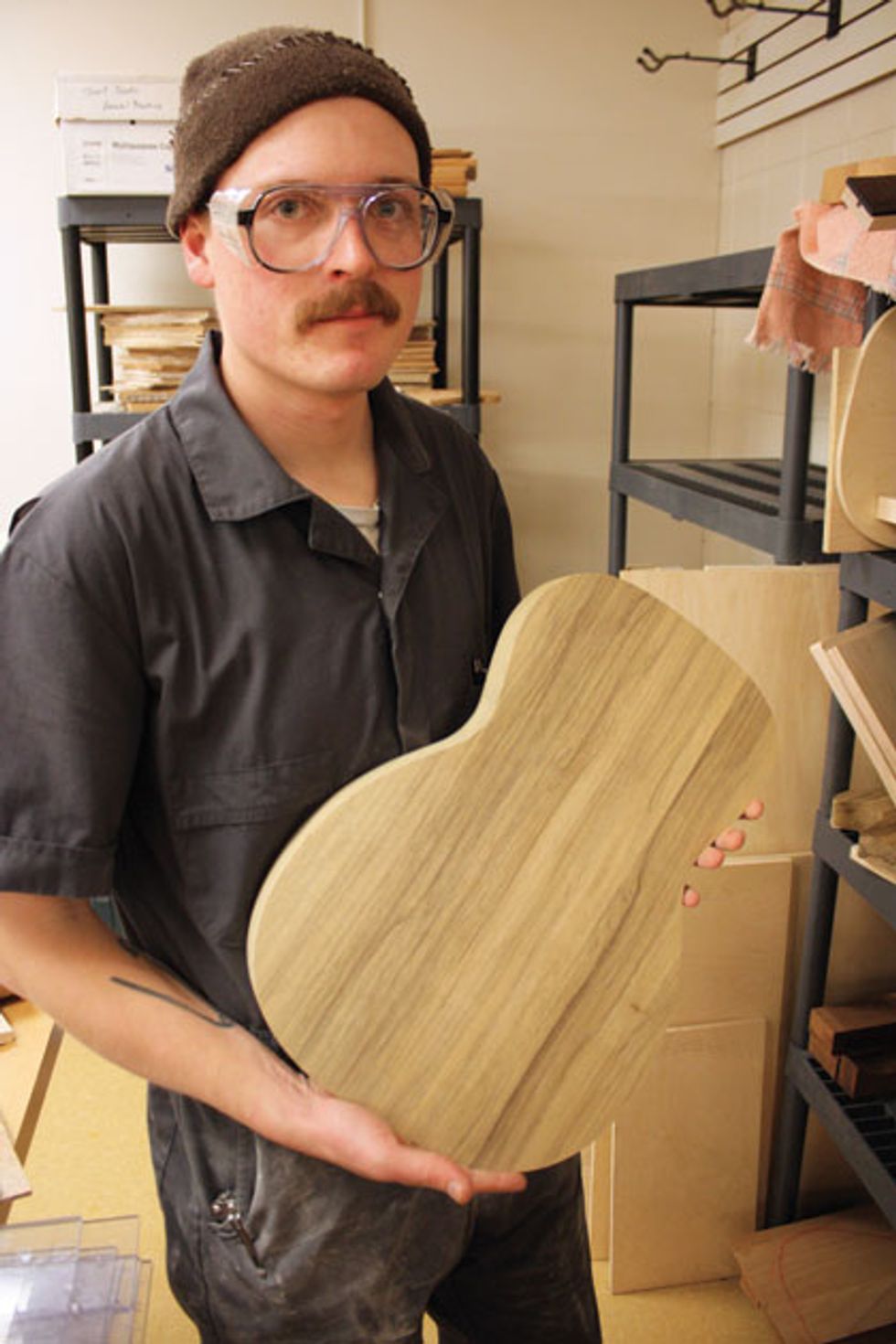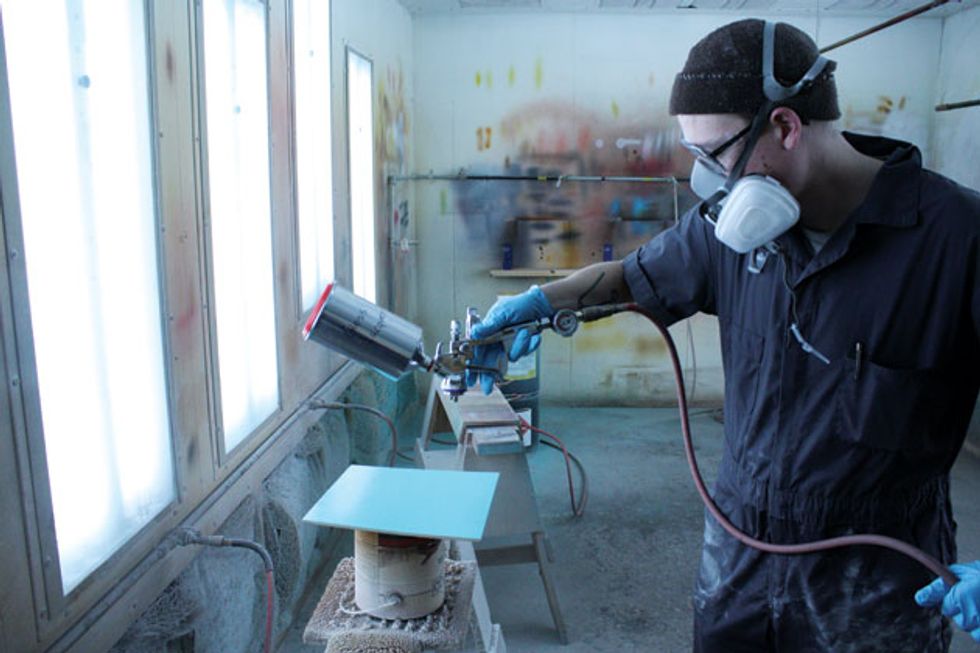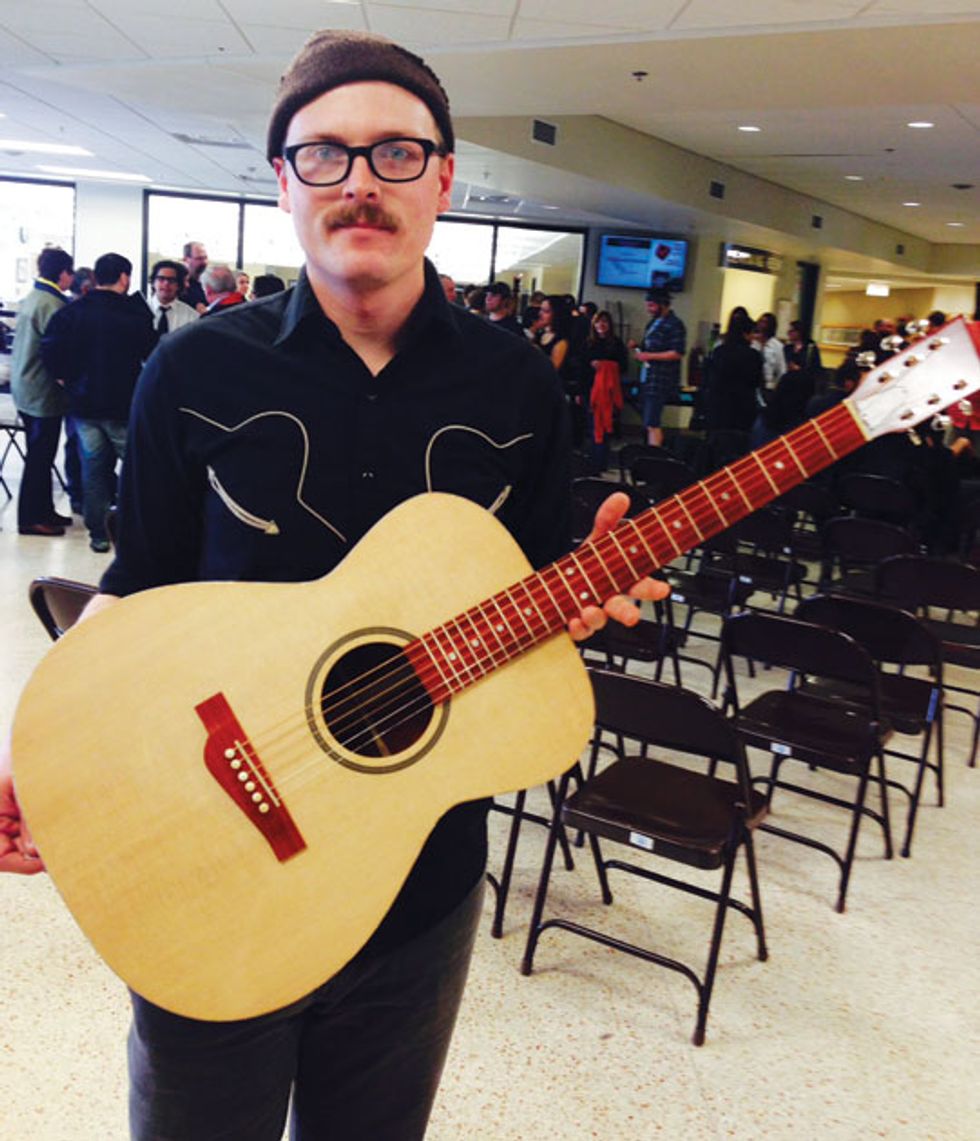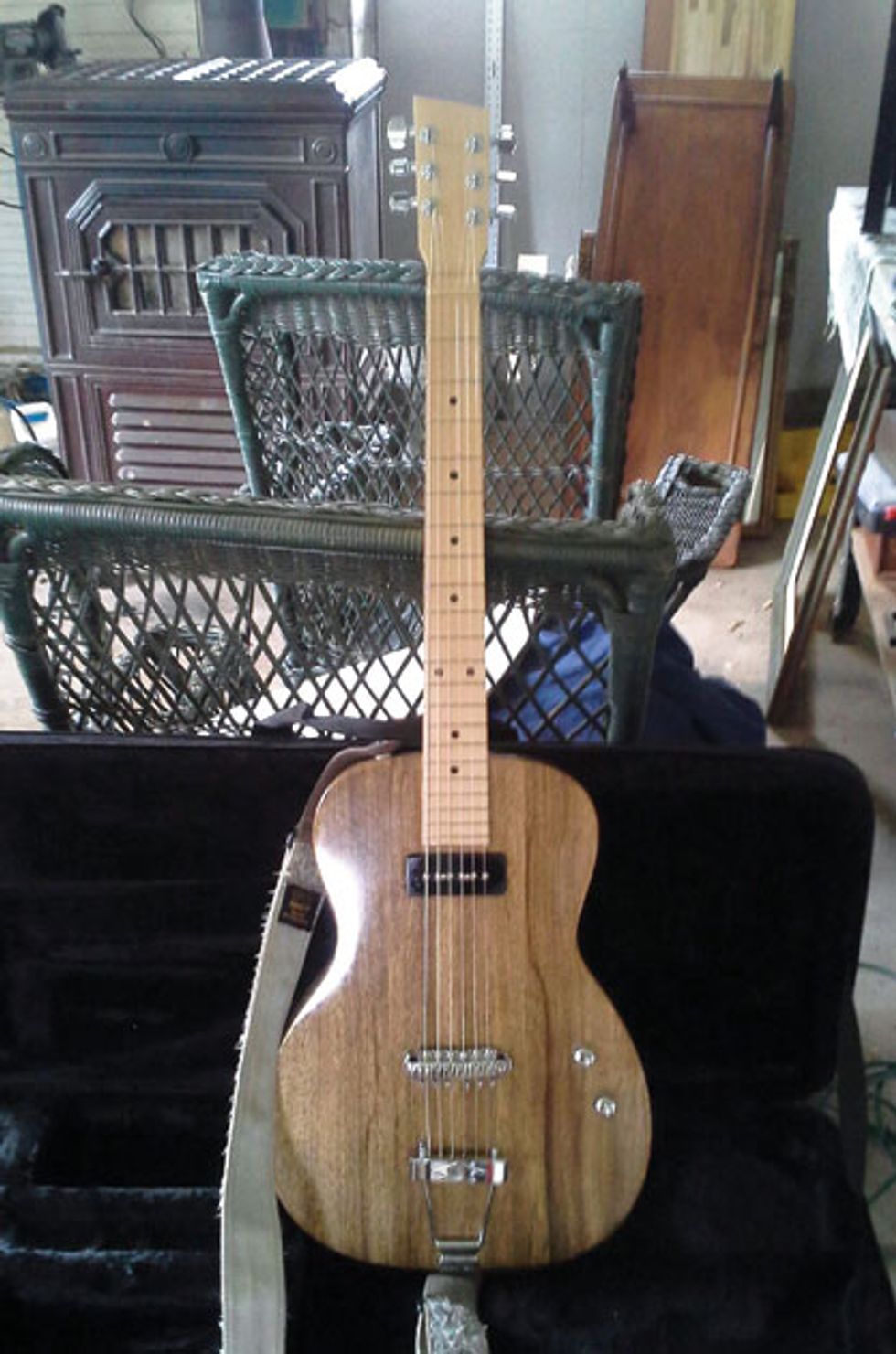In the summer of 2011, Colin Samek faced a grim problem while riding with his band to the next tour date: His guitar’s output jack plate had been ripped out during a violent show the night before, and now the jack was hanging loose. Time and money were tight, so he needed a creative fix.
Samek found a plastic soda bottle cap on the van floor. He heated a screwdriver tip with a lighter, punched a hole through the cap, and bored around the edges until the hole was wide enough for the jack. He fused the hole’s edges to the jack’s threads by heating them with the lighter, and then secured the makeshift plastic plate to the jack hole with a little super glue. The repair wasn’t pretty, but it survived the tour. MacGyver would have been proud.
Little did Colin know that in a few years he would be skillfully designing and building his own guitars.
Time for a Change
After two years working janitorial and attendant jobs, Samek enrolled in the Guitar Repair and Building program at Minnesota State College-Southeastern Technical in Red Wing, Minnesota. The renowned program, often referred to simply as “Red Wing,” has trained some of the world’s most skilled luthiers. Since the mid-’70s, graduates of both the one- and two-year programs have gone on to work for Fender, Paul Reed Smith, Collings, Benedetto, and other companies—or started their own.
“I had no idea that you could even go to school for such a thing,” says Samek, who had no previous lutherie experience beyond simple repairs and setups. “But a day came when I realized I needed to do something with my life.” He laughs. “Hey, if I’m still going to be mowing lawns, I’d like to have my own to mow.”
The students learn to measure and carve custom necks by hand. Samek based his profile on that of his old Aria acoustic.
Samek wasn’t the first student to enroll without prior training. Both Luther Zielsdorf and Daniel Thompson of Collings Guitars enrolled in Red Wing with little more than a love of all things guitar. “When I found out about the school,” recalls Zielsdorf, who completed the one-year program in 2004, “I wasn’t aware that there was an option to learn beyond an apprenticeship with a master luthier. I learned a lot very quickly about materials, techniques, you name it—and loved every minute of it.”
Thompson completed the one-year program in 2011. His prior experience was limited to working from a kit, plus the basic wiring repair he’d taught himself. “They have very high standards for everything there,” he says. “Whether it’s maintaining your tools or buffing a finish until it’s absolutely spotless, you gain a good eye for noticing imperfections. When I joined Collings, I’d already developed a high standard for quality at Red Wing.”
Instructors David Vincent, Brian Boedigheimer, Steve Rossow, and Mark Hayes provide students with a complete lutherie education in only four semesters. Many luthiers have trained under Vincent since he joined the program in 1984. Boedigheimer graduated from the program in 1994, and returned to teach after several years of repairing and building his own instruments, as well as working for Benedict Guitars.
Proper tool maintenance is crucial. Samek often sharpened his chisel the night before class.
The Right Stuff
All first-year students are required to design and build a traditional steel-string acoustic guitar by the end of the year. They’re also offered the option of building a bolt-on electric guitar, as Samek chose to do. Second-year students have the choice of designing and building a mandolin or an archtop guitar, plus the opportunity to use Red Wing’s facilities to build an additional acoustic guitar, electric guitar, or mandolin. Entering students receive a list of needed tools and supplies, along with course syllabi listing reference books from experts like Dan Erlewine and Les Schatten.
Classrooms are customized to accommodate Red Wing’s unique process: The first-year classroom is laid out with large desks that students use for most of their daily work and smaller projects. There are also several larger drafting desks for projects requiring extra space. An illuminated counter serves as a demo area for lacquer mixing, wiring, and soldering techniques. The dozens of electric guitars of varying styles hanging on the wall are used for setup and repair training. An adjacent room contains a walk-in spray booth and drying area for practicing painting and finishing techniques.
Samek sourced padouk, mahogany, and Sitka spruce blanks for his acoustic guitar.
Second-year students have access to a fully equipped woodworking shop, including a three-axis CNC router. Their program includes a class on using the machine to create molds and templates, plus a prerequisite course on computer drafting in AutoCAD. (The second-year program isn’t required for graduation.)
Samek, who starts his second year of the program in August of 2014, notes that the second-year students are always willing to offer advice. “It’s one of my favorite things about the school,” he says. “Students are willing to help create a dialog about the proper way to do things.”
New Beginnings
Since the drive from his home in Iowa City, Iowa, to Red Wing is over four hours, Samek decided to move closer to the school. His rent for a room on the outskirts of town includes use of the house’s garage and workshop, where Samek spends much of his time working on school projects.
Samek applying a sunburst finish in the paint booth.
Initially, Samek and his classmates were taught how to safely use and maintain hand and power tools. Students would huddle around Matt Hayes desk, watching him demonstrate things like the way to hold a chisel when sharpening it. The students would then return to their desks and try it themselves, testing the results on scrap wood. “It’s similar to high school shop class,” says Samek, “but focused on what would be used to build acoustic and electric guitars. They develop good rudiments.”
Sharpening a chisel to a hair-splitting tip might sound boring to some, but not to Samek, who often unwinds by cleaning and sharpening his hand tools to a soundtrack of classic country and R&B. “I've never had nice tools before, and it’s fun and exciting to be able to learn those techniques. Believe me—it’s a hell of a lot harder to do this type of work if you don’t have well-maintained equipment.”
After completing the tools course, Samek’s class spent the next few weeks on basic guitar anatomy, including steel-string acoustics, classical guitars, archtops, and electrics. The students were introduced to various types of electric guitar bridges and instructed on identifying the parts used in different types of tremolo bridges. Next came a two-part section on the history of acoustic and electric guitar development. “Understanding the history is important,” Samek explains. “Students are more likely to solve building and repair problems if they understand how the great inventors and luthiers of the past conquered those problems. It was part history, and part critical thinking.”
Samek and classmate Franziska Andonopoulos blend the edges of hand-applied bursts to achieve smooth transitions.
By this point students were encouraged to start thinking about the materials they’d use in their acoustic guitar projects. David Vincent discussed wood properties, how to identify woods by their shades and grains, and using “tap tone” techniques to select the most resonant pieces.
All first-year students take an electric guitar setup lab that trains them in proper stringing, adjustment, bridge installation, wiring, and basic repairs. They learn how to take essential measurements such as neck relief and extension height to determine things like optimal saddle height and nut slot depth. After the setups are graded, the teacher deliberately misadjusts them so the next class can fix them.
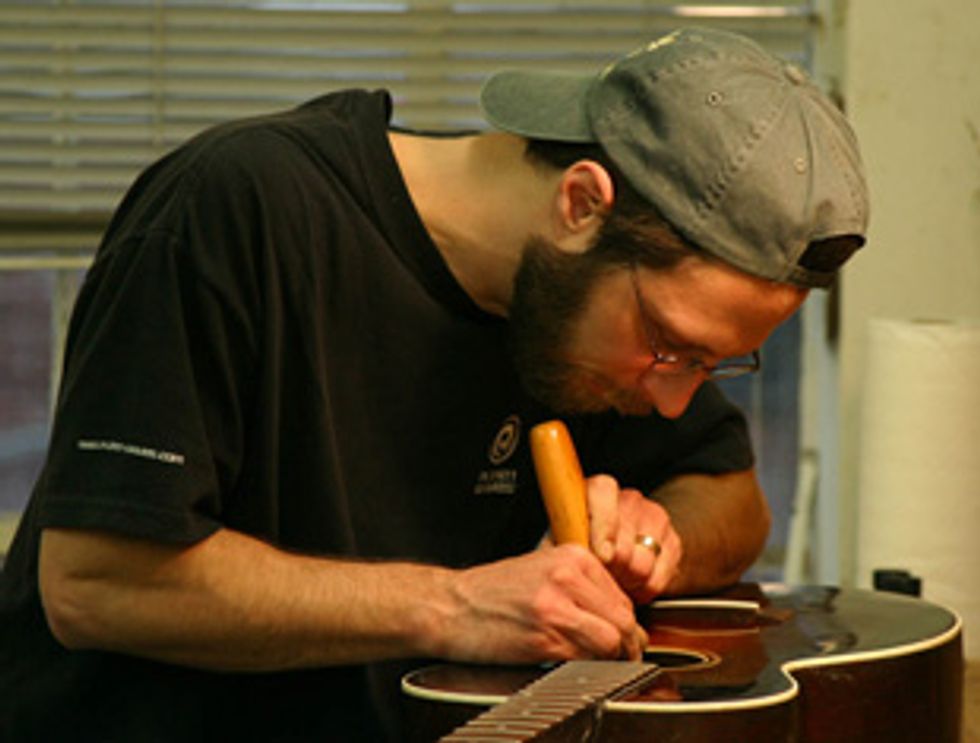
Lutherie: Lifelong Learning
The Guitar Building and Repair Program at Southeast Technical has trained many of the world’s most talented luthiers and technicians, and Nashville-based Andrew Jellison is certainly one of them. After graduating from the program with certificates in both guitar and violin construction and repair, Jellison worked for three years under the wing of celebrated luthier Ross Teigen before moving to Nashville to work for George Gruhn at his world-famous vintage guitar store. For 20 years, Jellison has contributed his expertise and devotion to Gruhn and his customers. We recently spoke with Jellison about his time at Red Wing and the skills he learned there, and also about lessons learned outside the classroom.
How has real-world experience helped you grow in your field?
Like most people graduating from school, I thought I had it all licked. I figured that I was ready to take on the world, and that I’d get a job doing what I went to school to learn how to do. But what I discovered really quickly was that I wasn’t prepared to face projects with so many inconsistencies. I certainly knew a lot of skills that would work in a lot of circumstances, but they rarely covered all of the circumstances completely. Every situation—even something mundane like, like a bridge re-glue—has unique characteristics that you have to watch out for. It’s especially true with older instruments with wood that has had years to deflect and turn into what it is now. It took me a while to realize that wood changes, just like people.
Did you come to that realization by the time you moved to Nashville and started working at Gruhn’s Guitars?
When I left Ross Teigen after three years and came to Gruhn’s, I thought that because I had some experience—as well as being young and naïve—that I was going to repair every broken guitar they had there. And after working on over 600 guitars in about 28 years, I know that was a completely ridiculous notion. Every repair and build has the potential for lots of unique variables—the problem is that you don’t know what they are until you dig in and start to work on them.
Are there skills or lessons that you learned at Red Wing that you still use in your career today?
Oh, sure. I can look back now and still remember things that both David Vincent and Elizabeth Butler taught me that are still very useful and significant to this day. Elizabeth had two mottos that have stuck with me throughout the years, the first being, “the light is your friend,” and the other is, “flat and square.” Knowing those two things have carried me through more tasks working with any material than anything else that I’ve ever learned. If I’m trying to join two pieces of wood, for example, using light effectively will give me a very good indication of whether or not they’ll match and work together. And if they’re not flat and square, I’m most likely going to have a problem.
Obviously, not everything that either myself or other techs might work on is going to be flat and square—one example might be working on a backside-radiused bridge for an older Gibson acoustic. In those types of situations where it’ll boil down to having to hand-fit something, I really appreciate how much Elizabeth made us work on small details by hand. She forced me to use my eyes to notice details that I didn’t think I could see.
Those types of skills are becoming scarcer as technology progresses.
Technology is a fantastic thing, and it’s been really great for a lot of manufacturers in terms of their instruments’ costs, consistency, and quantity. There’s a Catch-22 to it, though. The instruments that are especially significant to me were built in the late 1800s, right around the time when Martin was really getting started in building their flattops and Gibson was ramping up their acoustic production. They didn’t have CNC machines, of course, but they had a lot more than just a simple set of tools. Those guitars had more hands touching them and putting them together than a CNC-made guitar being built in a factory today. It doesn’t necessarily make them better, but it makes them special. Many of these guitars have several people’s blood, sweat, and tears put into them. They were learned skills that those people prided themselves on. And those guitars have souls.
So the school strengthened your perception and abilities to see less-noticeable imperfections?
Yeah, it did. It gave me a good place in which to start and many things that I still rely on. But there’s much out there to see. Even after all this time, I’m still learning new things every day, personally and skillfully.
Can you give an example?
It wasn’t until many years after working in this field that I had a moment to sort of, “step away” from what I’d been doing and look back on it. I realized that it had become more than just a job, and more of a philosophy for me. When I’m working on an instrument, I try to lock myself into a mode in which I’m focused solely on making it the best it can ever be—and when I figured out how mentally to remove myself from the equation and work for the instrument instead of on it, that had more significance than anything I was taught in schools.
Second-year students are taught such advanced techniques as constructing archtops and mandolins.
The Deep End
Over the course of the first semester, Samek and his class covered nearly every facet of conventional acoustic and electric guitar design. The curriculum covered such topics as the physics behind the movement of wood under varying degrees of tension, the use and identification of adhesives and abrasives, resetting acoustic necks, and fretboard leveling, radiusing, and refretting.
At times it was daunting. “Every new thing I’d attempt came with a set of nerves,” admits Samek. “But after a while, you just get locked into a mode, and it suddenly doesn’t seem as scary. For example, we had to do three acoustic bridge copies. We were given a wood blank and a bridge from a random acoustic guitar, and we’d have to make an exact copy—the height, angles, all of that stuff. I kept asking myself, how could I possibly make this exactly the same?”
Samek eventually realized that the assignment was designed in part to teach the all-important lessons of working slowly—and knowing when to stop. “We figured out that a big key was knowing when to stop instead of continuing to shape it,” he recalls. “After that, it came along much easier, and we worried a lot less about messing up. It taught me how important it is to get it ‘close enough,’ and then go back over it carefully to get it absolutely perfect, a little bit at a time.”
Instructor Brian Boedigheimer demonstrates brushing techniques.
Choosing the right tools after assessing a problem was another important lesson. For an assignment on making pyramid bridges for classical guitars, the students were given only a diagram to work from instead of a real-life example. Samek explains, “We had to figure out how to cut the pyramids properly, as well as what tools to use. It was harder than I expected! Should I use a scraper? A file? Maybe a chisel? It’s one of those things you don’t think about until you’re faced with it.”
When Samek’s class reconvened after Christmas break, it was time to start building the instruments that they’d designed the previous semester. Vincent and Boedigheimer gave the class pointers on acquiring wood, but allowed them the freedom to source materials for themselves. Lectures and labs led the class step-by-step toward completing their guitars while training them in finishing technique, structural repair, and how to calculate repair estimates for customers.
Samek holds the blank African limba body for his electric guitar.
Samek turned to the Gibson L-00 of the early 1930s for inspiration when designing his acoustic guitar. “I looked into a lot of designs throughout several decades, and the size and shape of that one really called out to me,” he says.
Using the dimensions and shape of the classic flattop, Samek drew up a large blueprint. The midsized dreadnought would have a back and sides of padouk, a Sitka spruce top, and a mahogany neck. Its fretboard and bridge would be made of padouk, with a maple bridge plate. There would be a soundhole rosette and pearloid binding. For a final personal touch, the neck shape would match Samek’s well-worn Aria acoustic guitar, though the instrument would feature Gibson’s 24.625" scale length. “I was going for a gaudy ’50s country and western look, which I think is pretty cool,” says Samek.
Samek practices spraying a Gibson-like Pelham Blue lacquer on a wooden blank.
Samek chose spruce for the top because of its ubiquity in acoustic guitar design, but says he selected padouk out of curiosity: “I also had no idea how it would sound, but I wanted to find out.”
His electric guitar was more eclectic. Samek wanted it to have a single P-90 pickup in the neck position because he’d never owned a guitar with that configuration. Using knowledge learned in class, he chose maple and African black limba for the neck and body, hoping their bright tonalities would balance out the tone. “I wanted something that wasn't as bright as a Telecaster, but not overly bassy either,” he explains. “I think I got what I was going for.”
Samek modeled the body shape on a ’50s Silvertone single-cut hollowbody electric borrowed from a friend, though his design omitted the cutaway. He chose black limba partly because of its similarities to korina. “It’s also easy to work with,” he notes, “and it looks awesome with a simple clear coat, which lets the wood’s amber color and black streaks come through.” The plans also included a glossy maple fretboard, 25" scale, Gibson-style tuner layout, Babicz Full Contact bridge, trapeze tailpiece, and a thin coat of nitrocellulose lacquer. Again, the neck shape would be modeled from his old Aria.
Samek displays his finished acoustic guitar. The instrument boasts back and sides of padouk, a mahogany neck, a Sitka Spruce top, a rosewood fretboard, and pearloid binding.
The Build Goes On
The extra time Samek spent studying and practicing paid off as he worked through his builds. He proceeded slowly and methodically, handcarving the necks, routing the truss rods, and installing the fretboards.
There were a few scares: At one point while routing a body off of a template, the end grain got caught and the body flew off the routing table, hitting the wall. “My stomach just sank,” recalls Samek. “I had to redraw the curve along the back and use a band saw to cut out the missing chunks.” The accident was a blessing in disguise, however—Samek actually prefers the body with its accidental streamlining.
Meanwhile, instruction continued. Boedigheimer tutored the students in finishing techniques, showing them how to use a color wheel to determine combinations, how to properly mix lacquers, and varying application techniques. In one lesson he explained how to apply a Gibson-style sunburst by using a yellow basecoat, and then applying a diluted red layer around the edge before rubbing it towards the center of the wood. The class practiced the technique using practice boards cut into Les Paul shapes. “It probably doesn’t help that I really don’t like sunbursts,” jokes Samek, who spent extra time in the finishing room making his burst absolutely symmetrical.
Samek’s finished electric guitar. The body is African black limba. The neck and fretboard are maple. Hardware includes a Stewart-MacDonald Golden Age P-90 pickup, a Babicz Full Contact bridge, and a trapeze tailpiece.
By mid-May Samek finally got to string up his finished acoustic and electric guitars—nearly 10 months after entering Red Wing with little professional guitar repair knowledge. His guitars were displayed with his classmates’ at the annual graduation guitar show, which draws students, alumni, and industry professionals.
Samek opted to return for the second-year program this year. “I’m really looking forward to building an archtop,” he says. “I’d like to know about the construction differences between archtops and acoustics.”
Samek emphasizes how friendly and comfortable the teaching environment is—and that even the best students always have something new to learn: “You could try to learn how to do this in your garage by yourself, and you might eventually develop sound ways of making things work. But you'll probably spend a lot more time and energy doing it that way, as opposed to being surrounded by teachers and students all focused on the same thing. It’s a nice community of reference and knowledge that’s hard to find anywhere else.”



